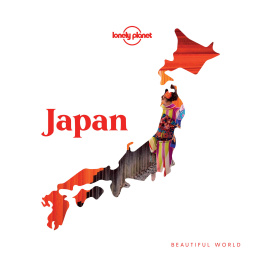



INTRODUCTION
Ramen noodles, miso, sashimi. It would be easy to assume that Japanese cuisine is all about food.
But no. Or at least, its not just about the food. The cuisine of this teeming archipelago of 3000 islands is a living part of its culture. And much like the fibre of the Japanese soul, it has been shaped by the nations history, and not least by the rise, over a millennium ago, of Japanese Buddhism.
The sushi we know and love today owes its creation to the rise of the religion the popularity of early sushi proliferated after emperors banned the eating of meat. The dish, as with Japanese laws, has greatly evolved since then. The first sushi was not even eaten with rice; instead it was simply a meal of fish that had been preserved in the fermenting grains.
In Japan its believed that food should be devoured with all five senses: not just smell, taste and sight, but also touch (the texture of ingredients, the smooth warmth of bamboo chopsticks), and even sound (a high-end ryotei is oddly quiet, the better to appreciate the experience of eating).
Like rice, which originally came from China, the introduction of the Five Elements Philosophy has shaped Japanese cuisine for centuries. Focusing on earth, wood, fire, water and metal, the philosophy rests on the principle that each element must be balanced against each of the others, in order for the world and everything in it to maintain its equilibrium.
Put simply, each type of ingredient relates to one of the five elements by its taste and colour: sweet and yellow, orange or brown to earth; sour and green to wood; bitter and red to fire; salty and black, blue or purple to water; and spicy and white to metal. Even cooking techniques link to one of the five elements: boiling, steaming and poaching to water, for example, and smoking to wood.
Any Japanese meal from simple home-cooked fare to the most structured, formal kaiseki aims to blend each of these elements for balance and nutrition. Unsurprisingly, this provides myriad benefits for our health, as does the act of lingering over our food and cherishing each mouthful with all our senses the latter has been proven to aid digestion and portion control. Its clear that meals taken the traditional Japanese way are good for us. That they are such a pleasure to consume, too? Well, thats just a happy coincidence.


COOKS NOTES
This book aims to deliver Japans best local dishes direct from the kitchens where theyve been perfected and practised for decades or generations. Authenticity is at the heart of every dish we feature.
That means that some ingredients may be difficult to find in general stores. Most should be available in Asian supermarkets or online but, where possible, we have suggested more easily sourced substitutes, too. The will help to identify unfamiliar ingredients.
In the spirit of authenticity, we have retained the chefs original methods in these recipes, but have always tried where possible to offer alternatives, to help you produces these dishes when time is pressed or specialist equipment not available.
For basic recipes for rice and .

NORTHERN JAPAN
Stews and soups are popular in these cooler climes, along with local seafood specialities, such as salmon and crab in Hokkaido


Squid croquettes

Scallops simmered in miso

Miso soup with crab

Hand-pulled noodle soup

Noodle soup

Hakodate seafood rice bowl

Barbecued beef tongue with beef tail soup

Taro stew

Smoky mutton and onions

Braised whole fish wrapped in kombu

Crushed soybean rice cakes

IGA-MENCHI
Squid croquettes
These crisp-fried croquettes of juicy squid, sweet onion and vegetables are a staple in the northern Tohoku city of Hirosaki. The Tsugaru Akatsuki Club members champion homemade.
Chef //
Sumago Kudo
Location //
Tsugaru Akatsuki Club, Aomori

I ga means squid in the Tsugaru dialect of western Aomori. The local variety, Pacific flying squid yes it really can propel itself up and over the water comes from the Tsugaru Strait, the freezing stretch of water that separates Tohoku, the northernmost part of mainland Japan, from the more-northern-still island of Hokkaido. Hirosaki, an old castle city on the Tsugaru plains, is 50km south of the strait. In the old days, squid was a real luxury and we only served it for company. Now its a one-hour drive to the port, but before cars it was a day in a horse and carriage, explains Samago Kudo, the leader of the Tsugaru Akatsuki Club.
The Tsugaru Akatsuki Club members are active in preserving and gathering traditional recipes from the Tsugaru region of Aomori. All of the members belong to farming families. Kudo, now 75, founded the group 20 years ago, prompted by the desire to preserve the knowledge and traditions of the older generations, those who could remember the days before cars and refrigerators.


































